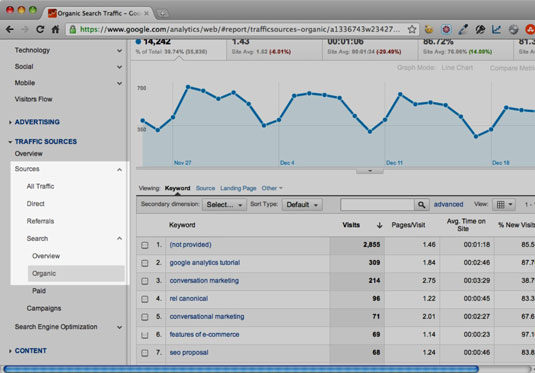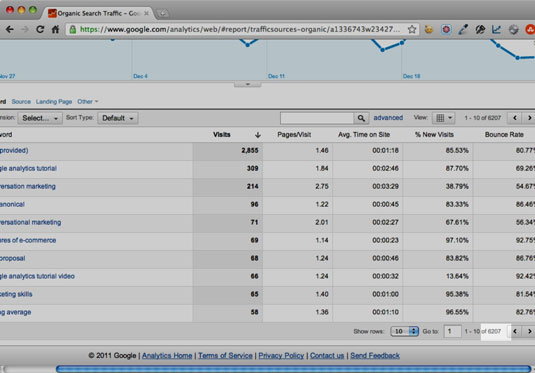SEO is a long process. In order to be successful in web marketing, you will need to analyze your results. Changes you make now may take months to actually impact your traffic, so you need your worksheet to provide a long-term look at what worked.
Use your tracking worksheet
If you haven’t set up your worksheet yet, get going!

The tracking worksheet helps you do the following:
Boost morale: Search engine optimization is a long-term game. Progress may happen in months . . . or years. You can look back six months and see that you really have gotten a lot more traffic and conversions.
Match changes in search with changes in sales: If your offline or phone-driven sales jump 90 percent and your search traffic jumped 90 percent the same month, but nothing else changed, chances are that your SEO efforts helped create that burst.
Obtain a big-picture look at what helped search engine optimization: If you added ten new pages in March and your keyword diversity jumped 50 percent in April and May, that’s valuable intelligence that you can use to guide your next steps.
If you’re getting fewer than 10,000 visits per month, you can update the worksheet monthly. If you get more than that, you might want to consider weekly updates, but you must consider how much time you have to devote to updating your worksheet.
The following list explains each of the basic statistics on your worksheet and describes where to find this data in Google Analytics or on the search engines themselves.
Traffic from organic search: In Google Analytics, choose Google Analytics→Traffic Sources→Sources→Search→Organic. The report that appears shows you all of the keywords generating traffic to your site and the amount and quality of traffic generated.

Keyword diversity: In Google Analytics, choose Google Analytics→Traffic Sources→Sources→Search→Organic. Keyword diversity tells you the number of unique phrases generating traffic to your site. It’s a fantastic measure of campaign health. More phrases means folks are finding you more ways, which makes for a more stable flow of traffic.

Incoming links, by search engine: Links are votes. So you want to keep track of progress as you build links. These two reports help:
Blekko: Search for your site’s web address. Then, next to the first result, choose SEO→Links.
Google: Choose Google Webmaster Tools→Your site on the web→Links to your site→Total links.
Indexed pages, by search engine: You need to know if search engines are seeing all of the pages on your site. Luckily, you can do that via Google Webmaster Tools: Choose Google Webmaster Tools→Diagnostics→Crawl Stats.
Conversions from organic search: SEO is marketing. Marketing works if it drives business. You can measure that by looking at conversions from organic search. Choose Google Analytics→Traffic Sources→Sources→Search→Organic. Then select the relevant goal set. Goals must be set up to use this metric.
Set up the links page
You want to track which links you have and which ones you want, too. Add a tab to your worksheet. On that page, have columns for the following:
The competitor and other links you want to get
The date you requested the link
The date you got the link
Having these columns helps you keep track of your link campaign and ensures that you don’t pester webmasters with multiple e-mails.
Enter your keyword list
Add a tab to your worksheet. On that page, have columns for the following:
The keywords you’re targeting
Your current ranking on Google and Bing
Changes from the previous report
This information is the least important data you’ll collect — traffic and conversions matter far more. Checking once per month is more than enough.

